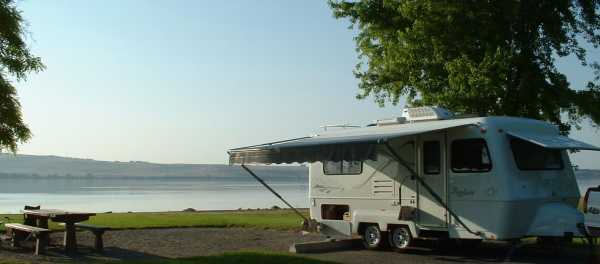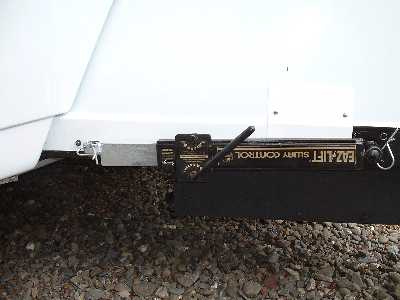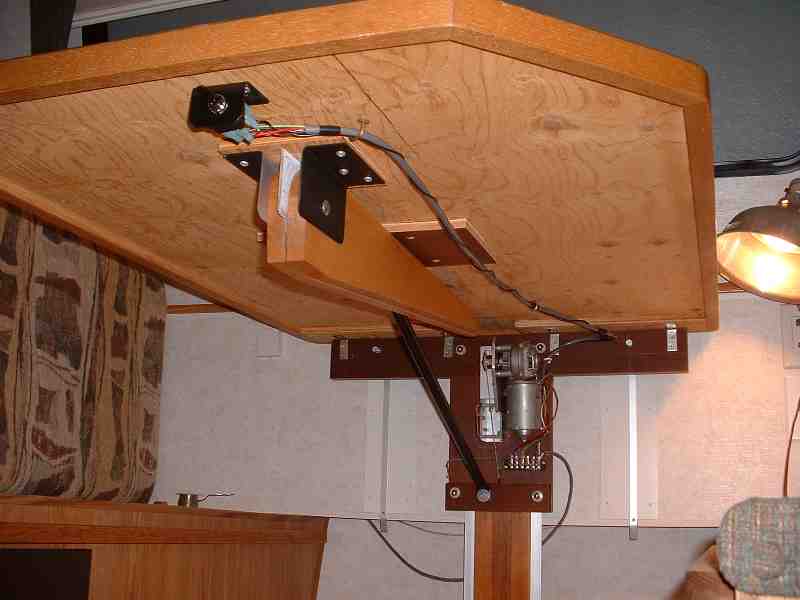
Sunset at Boardman State Park, Columbia River, Oregon

| Our
first
two "stick-built" trailers were disasters. After suffering
through the major repairs that resulted from crummy design and
construction, we decided enough was enough. We wanted sturdy, hail
and dent “resistant” construction that wouldn't leak. That ruled
out every contemporary aluminum clad trailer right off the bat.
We even looked at a couple of used Airstreams. Despite
the deluxe interiors, loosening rivets and fragile exterior skin
eliminated those, too. After crawling under some of the
deluxe fiberglass paneled units, we confirmed that they were
little better than their aluminum-skinned cousins. It became
obvious that molded fiberglass construction was all that
remained. Because our last trailer was a 19 footer, and that
size and feature set (larger water and holding tanks, etc.) seemed
to fit us well, we started checking out the Bigfoot line. Because of the
capricious nature of RV nomenclature, the Bigfoot 21' trailer
body measured almost to the inch the same as our old 19'
Sandpiper. By sheer luck, we found a 2002
21' Bigfoot on consignment in Sacramento, CA. It had
never been used because the original purchaser couldn't get it
up his driveway. Fortunately for us, unfortunately for the
buyer, the dealer figured that one trip home and back made the
trailer "used" (though the paper seal was still on the
toilet), with the consequent drop in retail price. So,
the used trailer, on consignment, got buried way out back
behind all the high-priced stuff. A quick query on the
forums at www.fiberglassrv.com
confirmed the price was good, despite being 50% more than
that of a similar sized new stick-built trailer.
But we expected that. Besides, we reasoned, the time
and cost we saved not fixing could be spent on the road.
We made a deal and drove our "new" Bigfoot home. |
Molded fiberglass construction is simply a superior travel
trailer design. Bigfoot has chosen to use a two piece
upper/lower fiberglass shell arrangement, bonded together at a
"belly band" that runs the entire circumference of the trailer.
The lower half is entirely one piece fiberglass, just like
the sides and top. The only penetrations are for wiring, gas
lines, and plumbing, which are
all
sealed. (With
a
good fitting storage hatch and entry door, there's no reason the
trailer wouldn't float indefinitely.) This makes the
water infiltration and associated troubles commonplace with
conventional stick-built RVs not even possible with the
Bigfoot design. Unfortunately, the attention spent on the
snazzy design and engineering has not extended to the
assembly line. Despite the above
average interior finish and materials
quality, the inside needs a bit more thought and
planning applied to where things go and how they're
installed, the whole product would move from being quite good to
near perfect. Of course, it that was the case there
wouldn't have been anything left for us to do... So, here are a few mods and fixes we've done to our 21' Bigfoot to make it often better, and if not that, at least uniquely "ours". Some are trivial, some are difficult, some are easy. Some are unique to our rig and others can be found elsewhere on the web. So far, they've all worked and contributed to the fun we get from traveling around the country. Feel free to borrow anything you can use and don't hesitate to pass back improvements, comments, or ideas of your own. Bill & Arlene |
 |
Last edited June 17, 2013 |
|
|
Fixing
the
Pump – Making
more
room with less noise. |
|
|
Odds & Ends – Some miscellaneous shelves brackets, lights, etc. to make life easier. |
|
|
Adding a Second Battery – Stuffing another group 27 battery into the cowl area. |
|
|
Shelter for your Bigfoot – “Raising” a hardware store canvas shelter over your trailer. |
|
|
Dumping Facilitator – Add another dump valve to make your “sanitation engineer” happy. |
|
|
Installing a 1500 watt Inverter – Making those AC receptacles work anywhere. |
|
|
Cheap Skid Wheel – Looks like the expensive kind but isn't. |
|
|
Keylocks and Thumblatchs – Leave the keys (mostly) in your pocket. |
 |
Swaybar Support -- Don't be a slave to your swaybar (when unhooked) |
|
|
A Low Cost Inverter – A new life for that old Uninterruptible Power Supply (?) |
 |
The Electric Dinette Table -- Applying power to that dinette table. |
|
Things to do:
|
|